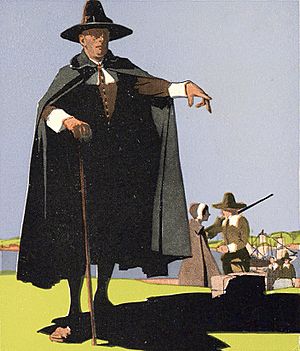Robert Treat facts for kids
Quick facts for kids
Robert Treat
|
|
|---|---|

Robert Treat depicted by Adolph Treidler for the 250th anniversary of Newark
|
|
| 23rd Governor of Connecticut Colony | |
| In office 1689–1698 |
|
| Preceded by | Position re-established |
| Succeeded by | Fitz-John Winthrop |
| In office 1683–1687 |
|
| Preceded by | William Leete |
| Succeeded by | Position abolished |
| Personal details | |
| Born | February 23, 1624 Pitminster, Somerset, England |
| Died | July 12, 1710 (aged 86) Milford, Connecticut Colony |
| Spouse | Jane Tapp Treat |
| Occupation | Farmer/politician |
Robert Treat (born February 23, 1624 – died July 12, 1710) was an important leader in early America. He served as the governor of the Connecticut Colony for many years, from 1683 to 1698. He also helped start the city of Newark, New Jersey.
Contents
Robert Treat's Early Life
Robert Treat was born in a place called Pitminster, in England. When he was just six years old, in 1630, his family moved across the ocean to Massachusetts. His parents were Richard and Alice Treat.
In 1637, his family moved again and were among the first people to settle in Wethersfield, Connecticut. A few years later, in 1639, Robert settled in Milford, Connecticut. He quickly became a leader in the New Haven Colony. He even served in their main government group, called the General Court.
On Christmas Day in 1647, Robert married Jane Tapp in Milford. They had eight children together. Jane passed away in 1703. Later, in 1705, he married Mrs. Elizabeth Bryan, who also passed away shortly after.
Robert Treat's Career
In 1665, the New Haven Colony had to join with the larger Connecticut Colony. Robert Treat led a group of people who didn't agree with this change. They decided to leave and start a new community.
In 1666, they moved to New Jersey. Other people from Branford, Connecticut joined them there. Robert Treat wanted to name the new place Milford, New Jersey. But another leader, Abraham Pierson, preferred the name New Ark. This place is now known as Newark. Robert himself moved back to Milford, Connecticut, in 1672 and lived there for the rest of his life.
Leading the Militia
Robert Treat was also a strong military leader. He was in charge of the colony's local army, called the militia, for several years. They often fought against the Narragansett Native Americans.
He played a big part in King Philip's War in 1676. He was named the Commander-in-Chief of Connecticut's forces. For example, Robert Treat and 300 Connecticut militiamen were crucial in a fight near Deerfield, Massachusetts. He also took part in the Great Swamp Fight, which was one of the most intense battles of the war. After these events, he served on the Governor's Council from 1676 to 1708.
Becoming Governor
Robert Treat was first chosen as Governor in 1683. However, in 1687, a new leader named Sir Edmund Andros took over. Connecticut became part of a larger area called the Dominion of New England.
Robert Treat is famous for helping to hide Connecticut's special document, its charter, in the Charter Oak tree. This was to keep it safe from Sir Edmund Andros. When the Dominion of New England system ended in 1689, Robert Treat became governor again. He was re-elected every year until 1698, when Fitz-John Winthrop became governor.
Robert Treat's Death
Robert Treat passed away in Milford, Connecticut, on July 12, 1710. He is buried in the Milford Cemetery.
Famous Descendants
Many notable people are related to Robert Treat, including:
- Robert Treat Paine (1731–1814), who signed the Declaration of Independence.
- Thomas Edison (1847–1931), a famous inventor.
- Margaret Sidney (1844-1924), who wrote the popular Five Little Peppers children's book series.
- Treat Williams (b. 1951), an actor.
See also
 In Spanish: Robert Treat para niños
In Spanish: Robert Treat para niños

